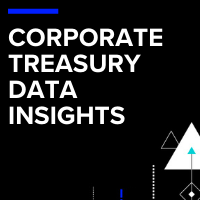Refinitiv Corporate Treasury Data Insights | July 2021
27-07-2021 | treasuryXL | Refinitiv |
Andrew Hollins, Director of Corporate Treasury Proposition at Refinitiv, brings you the July 2021 round-up of the latest Corporate Treasury Data Insights.
- The stability of the dynamic spread between USD LIBOR and its recommended replacement SOFR raises questions about whether corporate treasurers will gain much more benefit from credit sensitive rates over and above SOFR.
- Under pressure from inflation, what impact on financial markets could a move in the dollar index bring?
- Central banks, including the Bank of England and the European Central Bank, are exploring a central bank digital currency. What benefits would this bring the central banks?
Corporate Treasury Charts of the Month
Sources: USD LIBOR administered by ICE Benchmark Administration; SOFR administered by Federal Reserve Bank of New York
The dynamic spread between USD LIBOR and its recommended replacement SOFR mostly reflects the credit risk of large banks. This spread has remained stable at 13-14bps over the last few years and did not change materially during the COVID-19 related market volatility in H1 2020.
The stability of this spread, particularly during periods of stress, raises questions whether credit sensitive rates such as BSBY and Ameribor provide meaningful benefits over and above SOFR to corporate treasurers.
Tell me more
On 17 March 2021, the Alternative Reference Rates Committee (ARRC) announced it selected Refinitiv to publish its recommended fallback rates for cash products. Following extensive engagement, Refinitiv plans to launch prototype USD fallback rates in August 2021 and production rates in the autumn. Find out more about Refinitiv’s LIBOR Transition and Replacement Rate solutions.
LIBOR Transition Event: why does the USD cash market need fallback rates?
With the major banks expected to stop using USD LIBOR as a reference in the vast majority of new derivatives and cash products by the end of this year, the race is now on for market participants to accelerate their LIBOR transition programmes in order to ensure the ongoing and efficient functioning of financial markets.
In a recent webinar a panel of experts from Refinitiv, the LSTA, Wells Fargo and the U.S. Federal Reserve discuss the USD cash market and the need for fallback rates.
The Big Conversation: The two biggest risks for markets
Inflation may be the headline grabber at the moment, but it is the impact on bond yields and the U.S. dollar that really matter. If they don’t move, markets can tolerate higher inflation.
So far, bond yields have responded well to the inflation scare, but a move in either direction by the dollar could now be a problem. Discover analyst expectations for bond yields and the US dollar and assess the associated market risks.
Data on the Data: the rise of central bank digital currency
Major central banks around the globe have taken steps towards identifying a framework for building a central bank digital currency (CBDC). A CBDC would be a new risk‑free digital form of currency issued by a central bank, which performs all the essential functions of money.
Major central banks around the globe, including the Bank of England and the European Central Bank (ECB), are exploring the common principles and key features for building a CBDC.
In this new episode of Refinitiv’s Data on the Data, Sachin Somani, Global Director of the Central Banking Customer Proposition at Refinitiv, outlines the desire for central banks to develop their own digital currency to complement their existing offerings, reduce the reliance on coins and notes, and compete with private coins in the crypto space.
Watch: The Rise of Central Bank Digital Currency – Data on the Data | Refinitiv
Refinitiv Corporate Treasury Newsbeat
- Significant adoption of Refinitiv Term SONIA benchmark | Six months following the January 11, 2021 launch of Refinitiv Term SONIA benchmark there has been significant client adoption of the rate. Refinitiv now sees more than 220 users from 170 clients access the Refinitiv Term SONIA rate each week via our Eikon desktop and more than 110 clients access it per month using our real-time data feeds.
- Refinitiv launches Matching in Indonesia to facilitate first electronic marketplace for Rupiah FX trading | Strengthening our commitment to deepen financial markets in Indonesia and the Asia Pacific region, Refinitiv announced it has launched its leading global electronic trading Matching service in Indonesia, as the Southeast Asian nation focuses on further developing its financial market. The launch represents Indonesia’s first interbank electronic marketplace for the trading of Rupiah. How Refinitiv Matching will offer users in Indonesia the ability to explore liquidity sources, benchmark trades, and develop systematic FX trading strategies.
- Research reveals true impact of COVID-19 on supply chain due diligence | New research shows only 44 percent of organisations conducted third-party due diligence checks during the COVID-19 pandemic, as companies struggled to prevent extensive supply chain disruption by creating new third-party relationships. These are the findings of the new Refinitiv report ‘Global Risk Management Report 2021: How data, technology and collaboration are reshaping risk’.














